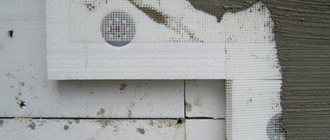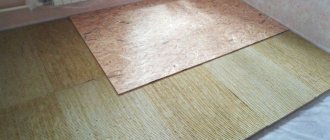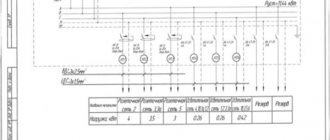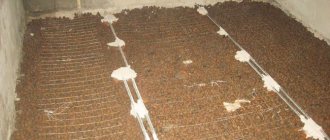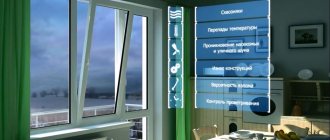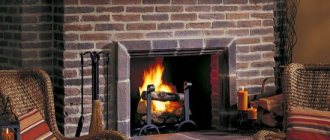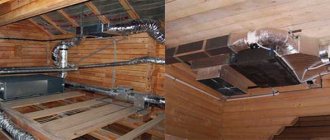When a resident of a metropolis or a country cottage decides to hang a horizontal bar at home, it seems like a simple task to him. You take a drill or hammer drill, drill the walls, drive in the fasteners and install the crossbar. But as practice shows, there are pitfalls - walls made of fragile materials, against which the desire to play sports can be broken. Therefore, in this material we will tell you:
- How to fix a horizontal bar on walls made of concrete and hollow bricks.
- Why do you need a chemical anchor?
- How to use a chemical anchor.
- Is it possible to hang a horizontal bar on a wall made of expanded clay concrete blocks.
- How to install a horizontal bar over a doorway.
Difficulties in fastening the horizontal bar on walls made of concrete, slotted brick and expanded clay concrete
When choosing a method for attaching a horizontal bar at home or in an apartment, you first need to consider the type of wall materials.
The reason is that if the user weighs 90-100 kg and trains with additional weights, then the support is subjected to a serious load and increased dynamic impact. If you install the horizontal bar “like everyone else,” then a situation may arise that the wall will not hold up, and the sports equipment will pull out the fasteners from it, or the structure will begin to sway.
Courvoisier FORUMHOUSE user
I decided to install a horizontal bar at home. The walls are concrete. I started making holes with a hammer drill and it turned out that the concrete was loose, crumbled a lot and was drilled, like plaster. And the loads on the horizontal bar will be serious. I'm afraid he might tear out the fasteners. I can’t attach the horizontal bar to another wall. Will it help if you hammer dowels with some kind of glue into the drilled holes in advance to make them hold tighter?
The situation is similar with Peter St. Petersburg.
Peter St. Petersburg User FORUMHOUSE
I hang a horizontal bar on the balcony. The walls are hollow slotted brick. The horizontal bar has 8 attachment points. For the first time I secured the horizontal bar with nylon dowels 10x90 mm. Unreliable. The structure is shaking. The second time I took 10x200 mm anchors. All the same. You can't really work out. I think maybe pour cement into the hole first, and only then install the dowels. What do you say?
Bags86 FORUMHOUSE user
My load-bearing walls are made of expanded clay concrete block. When I drilled them, I discovered that the blocks were hollow. Those. there is 50 mm of material, then 30 mm of void, again 30 mm of material, 30 mm of void and again expanded clay concrete. I weigh 95 kg. The design of the horizontal bar will begin to work like a lever, i.e. the load at the attachment points will exceed 100 kg. I'm afraid that the blocks will crack or the fasteners will pull out under my weight. What is the best way to secure the horizontal bar?
So, having identified the problems, below we will tell you how to solve them.
Wall horizontal bar in the apartment
The best models of horizontal bars from leading manufacturers
Horizontal bars are a fairly popular product, so the domestic market offers a large number of models produced in different countries of the world. Among them, the most popular brands are “Rusich” and “Plastep”, “Vertical” and “Green Hill”, as well as “Pro-Sport”, “Workout” and “Pioneer”.
WORKOUT H3 PRO
Appearance of the horizontal bar model “WORKOUT H3 PRO”
Main technical characteristics of the model:
| View | Dimensions (L×W×H), mm | Maximum load, kg | Material | Weight, kg | Compound |
| Wall | 1000×500×380 | 150 | Steel and powder painting, rubberized handles. | 6,9 | Collapsible |
Review of the “WORKOUT H3 PRO” model:
More details on Otzovik: https://otzovik.com/review_6429814.html
The cost of the model in different trade organizations varies somewhat; currently the following information is presented on Yandex.Market, namely:
"TN-2" (Record-sport)
Appearance of the horizontal bar TN-2 (“Titan”)
Main technical characteristics of the model:
| View | Dimensions (L×W×H), mm | Maximum load, kg | Material | Weight, kg | Compound |
| Wall | 1100×400×330 | 300 | Steel and powder coated, neoprene handles. | 4 | Not collapsible |
Review of the TN-2 model:
More details on Irecommend: https://irecommend.ru/content/nakachivai-telo-s-trenazherom-th-2
The cost of the model is:
“Pro horizontal bar-parallels-press 3 in 1”
Appearance of “Pro horizontal bar-bars-press 3 in 1”
Main technical characteristics of the model:
| View | Dimensions (L×W×H), mm | Maximum load, kg | Material | Weight, kg | Compound |
| 3 in 1 | 1100×480×710 | 250 | Steel and powder painting, rubberized handles. | 13,5 | Not collapsible |
Review of the “Pro horizontal bar-parallels-press 3 in 1” model:
More details on Otzovik: https://otzovik.com/review_5148280.html
The cost of the model is:
How to hang a horizontal bar on a concrete wall using a chemical anchor
If during pull-ups your head is busy with thoughts: will the horizontal bar fall off or not, then such exercises are of little use. Therefore, we listen to the advice of portal users.
Vasya-Vasya Member of FORUMHOUSE
If the wall is made of low-quality concrete or porous material (foam or aerated concrete), then I recommend installing the fasteners for the horizontal bar on a chemical anchor. The pleasure is not cheap, but the result is worth it.
The user advises buying a threaded rod with a diameter of 10-12 mm. Cut off as much as needed from the workpiece along the length, adding the thickness of the horizontal bar fastening plate to the depth of the hole in the wall and leaving 2 cm for the nut and washer.
Then proceed like this:
- A hole is drilled in the wall to the required depth.
The diameter of the hole should be approximately 2 mm larger than the diameter of the stud.
- The hole must be thoroughly cleaned of dirt and dust .
- Place the plastic mixer (spout with extension) onto the cartridge (tube) with the chemical anchor.
- Slightly bleed the two-component chemical anchor composition (glue mixed with hardener) from the spout so that it is mixed in the mixer until a uniform color is obtained.
- Insert the faucet spout into the drilled hole to its full depth.
- Slowly squeeze out the composition (avoiding the formation of air cavities), while simultaneously removing the mixer spout with the cartridge from the hole.
- Install the pin by screwing it clockwise into the hole.
- It is better to immediately wipe off the remnants of the composition squeezed out from under the stud from the wall, so as not to clean off the already hardened mixture later.
- After the mixture has hardened, hang the horizontal bar on the wall, and after a few hours you can already use it.
Before using a chemical anchor, be sure to read the manufacturer’s instructions on its proper use in various materials, the “lifetime” of the composition and the timing of its polymerization. To protect skin and eyes, work should be carried out with gloves and construction glasses. The drilled hole can be cleaned of dust with a special brush suitable for the diameter of the hole, and blown several times with a vacuum cleaner or a hand pump with a tube attachment.
What is Gipsolit?
[guns + gr. stone] - building material - a mixture of gypsum with mineral or organic substances; lightweight, conducts heat poorly; gypsum boards are used for partitions, wall insulation, etc.
Interesting materials:
Where are the largest ozone holes? Where is Mount Elbrus located in which city? Where is the city of Singapore? Where is the card reader on a laptop? Where is Hogwarts in the book? Where is the Backspace button on the keyboard? Where is the cross on which Jesus Christ was crucified? Where is the Stoloto ticket number? Where is Old Zealand? Where is the stash of driftwood?
Fastening the horizontal bar to a wall made of slotted bricks using a chemical anchor
We already wrote above that Peter SPb was unable to hang the horizontal bar on a wall made of slotted brick using dowels. The reason for the failure is the voids in the material in which the fasteners are not properly fixed.
To fasten the horizontal bar in a slotted brick, you can try using a special dowel, in which the lamellas open 360 degrees.
If this does not help, then the best option is a chemical anchor.
The technology for attaching a horizontal bar in slotted brick (warm ceramics) is somewhat different from the method of attaching a sports exercise machine to “chemistry” in a concrete wall. Let's use the advice of FORUMHOUSE user with the nickname Shvak. We proceed according to the following scheme:
- Holes in the brick wall are drilled from a diameter of 10 mm to a diameter of 14 mm.
To reliably fix the pin in the slotted brick, you need a special sleeve with a diameter of 14 mm and a length of 90 mm, which will form a hole in the voids of the material . You can buy a ready-made plastic sleeve.
Or make it from a stainless steel mesh metal sleeve, 1 m long.
In this case, the required length of the hole drilled in the wall is cut off from the sleeve. One end is flattened with pliers, and the sleeve is ready.
- Buy a stud with a diameter of 10 mm and cut off the fastening element from it at the rate of: 200 mm (depth of the already drilled hole) + thickness of the bracket + washer + nut + 4 mm (reserve).
The length of a homemade hairpin in the case of using a plastic sleeve (9 cm long) is about 11 cm.
- Insert all the sleeves into the holes in the wall.
- Without breaks, within 5 minutes, fill all the cartridges with the chemical composition.
- Insert all the pins by turning them clockwise.
Technology for installing studs on a chemical anchor in the wall
When installing studs, it is important that the chemical composition is squeezed through the mesh of the sleeve so that a kind of “lock” is formed in the voids of the brick.
- While the composition has not set, put on the brackets from the horizontal bar to accurately center all the studs.
Shvak
The chemical anchor sets in 5-7 minutes. After 30 minutes, you can hang the horizontal bar on the studs and, placing washers, tighten the nuts. When the composition sets, the chemistry heats up. This is a normal process.
After the mixture hardens, a strong connection is obtained that can withstand a load of up to 500 kg per attachment point. In fact, it is possible to pull out a stud attached to a chemical anchor from a wall only by destroying the material.
Important: for indoor use in residential premises, you must use a chemical anchor that does not contain harmful styrene!
Hairpins
When I came to the nearest hardware store to see what they were, doubts began to overcome me again. Will a M10 threaded stud support the required load?
And then I went online again (copying the address of the supplier’s website from the store pin label).
It turns out almost everything
studs that are sold in hardware stores have
steel strength class
4.
Typically, the strength class is indicated by two numbers with a dot between them (for example, “4.8”). The first number is strength, the second is “fluidity”. I'll send you to a search engine for details :). I’ll just say that strength class 4 means that the ultimate tensile load is 40 kgf/mm 2 (to calculate the total ultimate strength, you may also need the formula for the area of a circle S = r 2, where = 3.14; r = radius from which you need not forget to subtract the thread).
I managed to find a company on the Internet that sold such studs, but made of steel with strength class 8 (twice as much as a regular stud!). Fortunately, they were even coated - galvanized. This pin has a special yellow mark on the end. Costs $4 (for 2 meters). That's what I bought.
BY THE WAY
At the same company where I got the stud, they told me that they have studs with strength class 10 (!), unfortunately without coating.
But they weren’t there at that moment, and I didn’t want to wait anymore. In addition, the seller assured me that such studs are used only where the loads are absolutely prohibitive. Later, when everything was done, I found out that I could look for such studs in auto stores
.
There I also bought huge wide washers with a 16 mm hole made of thick steel, and slightly smaller ones with a hole diameter of 10 mm.
Fasteners for a horizontal bar on a wall made of expanded clay concrete
Let us remind you that Bags86 wants to hang a horizontal bar on an expanded clay concrete wall. He was offered this option.
NOnono__13 FORUMHOUSE Member
If you need a reliable fastening for a horizontal bar on the wall, then neither anchors nor bolts will solve the problem. They will simply be torn out of the expanded clay concrete wall. The solution is to increase the area of the bolt washers into which the nuts rest. And increase it hundreds of times. Therefore, instead of 4 washers, we will make this design.
- You need to weld two frames (from a corner, channel or profile pipe). The width of the frame is selected according to the length of the crossbar. The height is arbitrary, but not less than 1000 mm.
- Weld a crossbar onto one of the frames, through supports with jibs. One frame is on one side of the wall, the other is on the other.
- The corners of the frames are tightened with bolts passing through the wall.
Those. the wall is enclosed in a metal frame. Depending on the tasks, you can design your own structure. The downside is that the product is labor intensive and unsightly.
Bags86
The design is interesting and will withstand a lot of weight, but my walls are 50 cm thick, and I think ordinary fasteners will do the job, the main thing is to fix it securely in the wall. I called a company that sells horizontal bars throughout Russia and asked them how best to mount the horizontal bar on the wall. They replied that it is better not to guess and use a chemical anchor, and the longer it is, the more reliable the fastening.
In some cases, it is possible to fix a horizontal bar on the wall of a house or apartment only using a chemical anchor.
Small FAQ
1. What to do if the ceiling height is less than what is obtained from the above formula?
In any case, the minimum acceptable distance from the crossbar to the ceiling is 32 cm (regardless of the athlete’s height, age and body proportions, except for the exception described in paragraph 3).
If this distance is made smaller, then during particularly vigorous lifts, the force of inertia can lead to contact of the head with the ceiling, which demoralizes the athlete and is unpleasant in itself.
Therefore, if the ceilings in the room are too low, then the crossbar is simply fixed at a distance of 32 centimeters from the ceiling, and the height from the floor is whatever it turns out to be. The hanging position will only be possible with the legs tucked at the knees. Of course, this option is not very convenient, so it is advisable to avoid it.
2. What if I want to pull myself higher and higher?
Sometimes, in preparation for the “pull-up” exercise, athletes perform a non-standard pull-up, when the chin rises SIGNIFICANTLY above the bar.
In this case, the distance between the ceiling and the crossbar must be increased accordingly so that at the highest point of lifting the distance between the top of the head and the ceiling is at least 2 cm.
3. What should I do if I have a hydrocephalic head (hello Medvedev)?
No problem! It is only necessary to proportionally increase the distance from the crossbar to the ceiling in order to eliminate the possibility of damage to the ceiling covering and avoid subsequent expensive repairs.
Advantages and disadvantages
The spacer bar will be an ideal solution for those who want to improve their figure and do not have a lot of space for this:
- simplicity of design makes it easy to install or remove the projectile;
- the crossbar is installed in any door frame or between walls in a narrow corridor;
- The horizontal bar is always at hand and can be used to hang a children's swing or sports rings for a child.
But at the same time, the simulator is not without its drawbacks:
- installation of the projectile damages the surface of the wall or door frames, leaving unsightly marks;
- improper fastening can lead to collapse of the structure;
- a weak door frame is not suitable for installing a crossbar;
- limited choice of exercises that can only be performed under the horizontal bar if the apparatus is installed in the space between the doors.
When choosing equipment for a child, it is better to pay attention to the horizontal bar-spacer, as it is easy to install, remove and adjust to the height of the young athlete.
Small FAQ
1. What to do if the ceiling height is less than what is obtained from the above formula?
In any case, the minimum acceptable distance from the crossbar to the ceiling is 32 cm (regardless of the athlete’s height, age and body proportions, except for the exception described in paragraph 3).
If this distance is made smaller, then during particularly vigorous lifts, the force of inertia can lead to contact of the head with the ceiling, which demoralizes the athlete and is unpleasant in itself.
Therefore, if the ceilings in the room are too low, then the crossbar is simply fixed at a distance of 32 centimeters from the ceiling, and the height from the floor is whatever it turns out to be. The hanging position will only be possible with the legs tucked at the knees. Of course, this option is not very convenient, so it is advisable to avoid it.
2. What if I want to pull myself higher and higher?
Sometimes, in preparation for the “pull-up” exercise, athletes perform a non-standard pull-up, when the chin rises SIGNIFICANTLY above the bar.
In this case, the distance between the ceiling and the crossbar must be increased accordingly so that at the highest point of lifting the distance between the top of the head and the ceiling is at least 2 cm.
3. What should I do if I have a hydrocephalic head (hello Medvedev)?
No problem! It is only necessary to proportionally increase the distance from the crossbar to the ceiling in order to eliminate the possibility of damage to the ceiling covering and avoid subsequent expensive repairs.
Types of fasteners
Good fasteners are important for a horizontal bar. The durability of the unit depends on the strength of installation. Let's look at different types of fasteners and choose the appropriate design.
Interesting! Fastening elements can, even need to be combined. Naturally, without fanaticism. An excessive amount of bolts will damage the wall, will look unsightly, and may result in injury when performing exercises.
Universal mounts
Universal fastenings include metal hooks. They are used to install sports equipment.
The thickness of the hooks is 2 millimeters, made of metal. They are attached to the wall with anchor or dowel bolts; these will be discussed later. The product is “hung” on hooks.
This mount can withstand a load of 250 kilograms on a wall made of any material (concrete, brick).
Dowels
Dowels or dowel bolts are a favorite fastener for beginners. This is due to ease of use.
A dowel is a bolt with a diameter of 8-10 millimeters with a nylon plug. A hole a centimeter deep is drilled in the wall.
Dowel bolts allow installation on a surface of any material. Brick can withstand 200 kilograms of load, concrete - 300.
Anchors
The anchor is considered the most reliable fastening. A beginner cannot cope with it. To fasten a horizontal bar structure with anchor bolts, experience in construction is required.
Important! An error when fastening with anchors leads to instability of the structure. Operation as intended will be impossible - performing physical exercises on a fragile structure is life-threatening. Therefore, without the ability to handle anchors, it is better to use dowels.
Installation using anchors is “hardy” - it can withstand a weight load of 300-500 kilograms on a wall made of any material.
Homemade mounts
A homemade mount is any improvised installation option. This is an "alternative". You can use self-tapping bolts, glue, and other devices. For each solution, there are instructions and recommendations that are best followed. The glue must be allowed to dry completely.
Attention! When using any fastener, you must follow the instructions.
Equipment
The horizontal bar kit includes a stop bar, crossbar and anchors for standard fastening using drilling. For comfortable training, it is also recommended to purchase neoprene handles that stretch over the horizontal bar and prevent the formation of calluses on the palms. If you plan to change your grips when practicing on a horizontal bar such as a home horizontal bar without drilling, then you can buy several pairs of neoprene handles, or rather 3, to install them in three grips: regular, wide and narrow. Combining grips during exercise will allow you to evenly swing various muscles of the back, shoulders and arms without the use of additional equipment.
Characteristics
Characteristics of the horizontal bar in the opening
| Crossbar length | 100-120 cm |
| Crossbar diameter | 32 mm |
| Structure weight | 2 kg |
| Permissible load | 120 kg |
The crossbar is made of durable steel pipe, with a steel thickness of 3 mm. At the extreme points of the crossbar, wide nuts for spacer bolts are welded.
The diameter (thickness) of the crossbar at the grip points is 32 mm. The surface of the horizontal bar is covered with a special impact-resistant powder paint, which will retain its original appearance under any impact: impacts, chips, high abrasion from the metal fastening of hanging equipment - boxing bags, TRX loops, children's hanging accessories (swings, rings and bungees).
The horizontal bar is securely fixed in the opening due to the spacer mechanism and additional fixing plates, which are attached to the wall using dowels and self-tapping screws.
It is the spacer with the help of a threaded connection that provides reliable fixation of the horizontal bar in the opening and allows it to withstand loads of up to 120 kg. This horizontal bar is one of the most reliable and safe among the sports equipment we produce.

